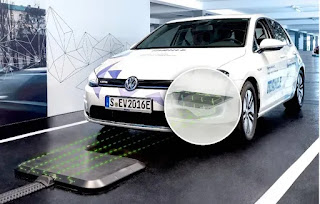 |
| The Future of EV Wireless Charging: DIPS Standard Paves the Way for Cross-Compatible, Efficient Charging Systems Image credit: Green Car Report |
Charging electric vehicles (EVs) may soon evolve beyond traditional charge ports, connectors, and cables, thanks to advancements in wireless charging technology. This new approach leverages the principle of electromagnetic induction, enabling vehicles to charge their batteries without any physical connection. The development of a standardized wireless charging ecosystem marks a significant milestone in the EV industry, promising a seamless and efficient charging experience.
Introduction of DIPS: Revolutionizing Wireless Charging Compatibility
At the heart of this wireless charging revolution is the Differential Inductive Positioning System (DIPS). DIPS utilizes a low-intensity magnetic field with multiple smaller coils, allowing it to recognize various ground assemblies and ensure precise alignment between the vehicle and the charging pad. This system is designed to work across different vehicle ride heights and weather conditions, making it highly adaptable and reliable. The standardization of DIPS, finalized by SAE International last November, opens the door for widespread adoption of wireless charging technology across the EV market.
Cross-Compatibility: A Unified Approach to Wireless Charging
The recent publication of wireless charging standards by SAE International, the same organization behind the Tesla-based NACS charging interface, addresses unidirectional wireless power transfer. This standardization not only facilitates vehicle charging but also supports applications where power stored in EV batteries can be sent back to the home or grid. The methodology behind DIPS ensures that components from various suppliers will be cross-compatible, allowing for the creation of diverse wireless charging systems, including driveway pads, vehicle units, and fleet systems.
 |
| SAE J2954 DIPS Overview Image credit: Green Car Report |
Efficiency and Performance: Meeting High Standards for Wireless Charging
One of the most impressive aspects of the new wireless charging standards is the efficiency they offer. According to SAE, these standards support wireless power transfer of up to 11 kW with an efficiency rate of up to 93%. This level of efficiency is nearly equivalent to that of traditional physical charging connectors, even when long charge cables are factored in. The establishment of such high standards through a "lengthy consensus process" underscores the reliability and performance of the DIPS system, making it a viable option for widespread use in EV charging.
Overcoming Challenges: Cost and Compatibility Concerns
While wireless charging technology offers many benefits, including reducing the reliance on DC fast charging and simplifying public EV charging, it has faced challenges related to cost and compatibility. The expense associated with wireless charging has so far prevented it from becoming mainstream, and concerns over compatibility have further hindered its adoption. However, with the introduction of the DIPS standard and increasing interest from major players like Tesla, wireless charging technology may finally be poised to break through these barriers.
 |
| EV wireless charging system Image credit: Green Car Report |
The Future of Wireless EV Charging: A Game-Changer on the Horizon
As the EV industry continues to evolve, wireless charging technology is emerging as a potential game-changer. The DIPS standard not only addresses previous compatibility concerns but also sets the stage for a more convenient and efficient charging experience. Although wireless charging currently costs more than traditional methods, its potential to revolutionize the way we charge EVs could lead to broader adoption in the future. With cross-compatibility now assured and major manufacturers showing interest, the era of wireless EV charging may soon be upon us.










0 Comments